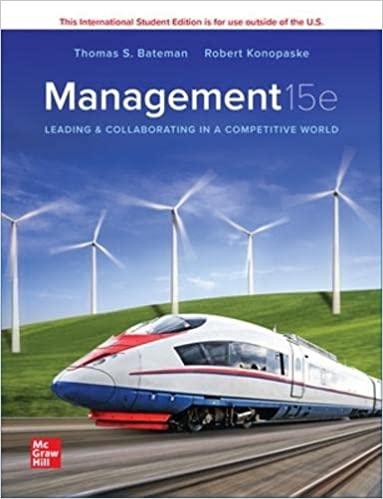1. Identify 3 students to play the roles of the employees. Ask these 3 individuals to read...
Question:
1. Identify 3 students to play the roles of the employees. Ask these 3 individuals to read their roles below.
2. Identify 1 student to play the role of the president of the social enterprise (Taylor Johnson). Ask this individual to read his/her role below.
3. Set up a table with 4 chairs at the front of the classroom.
4. Ask the remaining students in the audience to observe how the 4 individuals behave and then answer the discussion questions below.
5. When everyone is ready, Taylor Johnson joins the others at the table in her office, and the scene commences.
6. The meeting continues until there is a successful close unless an argument develops and no progress is made after 10–15 minutes.
DISCUSSION QUESTIONS
1. How did each member frame the problem? What did each member discuss?
2. How effectively did the group generate and evaluate alternatives?
3. What was its final decision?
4. Evaluate the effectiveness of the group’s decision making.
5. How could the group’s effectiveness be enhanced?
OVERVIEW
The role-play exercise is based on a meeting between a manager of a social enterprise and her 3 employees. Each character’s role is designed to re-create a realistic business meeting. Each character brings to the meeting a unique perspective on a major problem confronting the social enterprise as well as some personal views of the other characters developed over several years of knowing them in business and social contexts.
CAST OF CHARACTERS
Taylor Johnson, the president, founded the enterprise 10 years ago as a way to connect outstanding teachers who have recently earned their teaching degrees with students in schools located in economically disadvantaged areas.
The new teachers agree to serve in the disadvantaged schools for a 3-year period in exchange for a reasonably good salary and forgiveness of up to $30,000 of their student loans. Taylor is well known for her hard-driving, selfless style of leadership. A charismatic leader, she is highly skilled at bringing diverse stakeholders together. However, Taylor admits that she lacks knowledge related to online classroom and teaching technologies. In the old days, this wouldn’t be an issue. However, Taylor’s competitors are beginning to overtake the social enterprise by offering new teachers’ training, mobile devices, and online learning tools (e.g., online homework, interactive videos, e-books, and so forth) to help them create high-performance classrooms.
She doesn’t know whether the enterprise should continue doing what it does best (placing new teachers into traditional face-to-face teaching environments) or begin preparing its recruits to teach online and hybrid (combining face-to-face with online modules) classes.
Amit Patel, head of information technology, has worked for the enterprise for 6 months. A recent college graduate, Amit reports directly to Taylor. She is on a mission to modernize the way the enterprise does its work. She feels strongly that the enterprise should be shifting more of its IT operations to the cloud. Also, Amit feels that a great deal of insight could be mined from 10 years of data currently stored in antiquated servers at the enterprise. Amit believes she could make these changes without spending a lot of funds. Unfortunately, Amit’s zeal for rapid change has been a cause of concern for Felipe and Taylor who prefer a more methodical approach to change.
Felipe Rodriguez, director of fund-raising, reports directly to Johnson. He has held this position for 8 years and is a very close friend of Taylor’s. Donations and grants for the most recent year are down by 10 percent. Prior to joining the enterprise, he worked as a fund-raiser for a major university in the region. The university offered a wide variety of online and hybrid courses. Felipe would often refer to these innovations when seeking donations from alumni. He was widely viewed as successful at his work.
Mike Clarke, manager in charge of recruiting new teachers, works for Felipe. After working for the enterprise as an entry level recruiter for two years, Mike was recently promoted to this position. Though a persuasive recruiter of new teachers, he has noticed a recent decline in the number of recruits willing to teach in traditional face-to-face learning environments.
He is progressive in his thinking and believes that the enterprise needs to change how it does business in order to keep up with the competitors. Mike and Amit feel they are agents of change and want to modernize the enterprise.
TODAY’S MEETING
Taylor has called the meeting with these three managers to decide whether the social enterprise should begin preparing its new recruits to teach not only traditional face-to-
face classes, but also hybrid and online classes. This decision has to be made within 15 minutes because the enterprise’s largest client just called and asked to meet with Taylor immediately. Taylor is concerned that the school may be on the verge of discontinuing the contract with the enterprise. If that’s the case, Taylor wants the managers to help her decide on a counteroffer to win back the client school. Losing this client school is not an option given that it makes up 40 percent of the enterprise’s revenue.
Step by Step Answer:

Management Leading And Collaborating In A Competitive World
ISBN: 9781265051303
15th International Edition
Authors: Thomas S Bateman, Scott A Snell, Robert Konopaske





